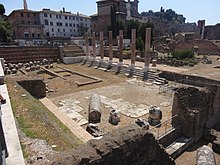Temple of Peace, Rome

The Temple of Peace (Latin: Templum Pacis), also known as the (Latin: Forum Vespasiani), was built in Rome in 71 AD under Emperor Vespasian[1] in honour to Pax, the Roman goddess of peace. It faces the Velian Hill, toward the famous Colosseum, and was on the southeast side of the Argiletum.
History[]
Statius claims that Emperor Domitian was largely responsible for the completion of the temple, not Vespasian - this issue remains controversial within the archaeological world today.[2] The Temple of Peace is part of the Imperial Fora which is "a series of monumental fora (public squares), constructed in Rome over a period of one and a half centuries." It is not officially considered a forum because there is no evidence of it serving a political function, therefore it is called a temple.
The funds to create this grand monument were acquired through Vespasian's sacking of Jerusalem during the Jewish-Roman Wars. The interior and surrounding buildings were decorated with the treasures collected there by the Roman army.[3]
Because Vespasian was both a leading general and later appointed emperor during the first war, the Temple of Peace was especially important to him as a leader. A grand and significant monument such as this is vital to the promotion of a powerful, strong public image of the emperor, and is a symbol of the peace and prosperity Vespasian was able to bring the empire.
The temple was destroyed by fire in February 192 AD. It was subsequently restored by Septimius Severus sometime around 203 AD. The halls were remodeled a century later, and were admired by the emperor Constantius II during his visit to Rome in 357 AD.[4]
If still in use by the 4th-century, the temple would have been closed during the persecution of pagans in the late Roman Empire, when the Christian Emperors issued edicts prohibiting all non-Christian worship and sanctuaries.[5]
The Temple of Peace was damaged during the sack of Rome in 410 by Alaric I and was never restored after the event.[6]
Structure of the Temple[]

Although very little remains of the Temple of Peace in Rome today, we know much about its structure and layout thanks to the Forma Urbis, a large, detailed marble map of Rome and its buildings that was originally hung on a wall inside the temple in the 3rd century. The temple was made up of an apse that opened into a large portico. Columns separated the temple from the central unpaved, grassy area. This was different from the majority of other fora, which were typically paved. This area probably featured gardens, pools, statues, and other treasures acquired during the conquest of Jerusalem.
See also[]
References[]
- ^ Tucci, Pier Luigi (16 November 2017). The Temple of Peace in Rome (Cambridge University Press, New York 2017). Two volumes, 1,107 pages, 263 color and 87 b&w illustrations. Volume 1: Art and Culture in Imperial Rome (ISBN 978-1-107-16247-1). Volume 2: Remodelings, Conversions, Excavations (ISBN 978-1-107-16254-9). ISBN 9781108548816.
- ^ Anderson, James C., Jr. (1982-01-01). "Domitian, the Argiletum and the Temple of Peace". American Journal of Archaeology. 86 (1): 101–110. doi:10.2307/504296. JSTOR 504296.
- ^ "Temple of Peace". archive1.village.virginia.edu. Retrieved 2015-11-10.
- ^ Tucci, Pier Luigi. The Temple of Peace in Rome. United States, Cambridge University Press, 2017, pgs. 246-258.
- ^ R. MacMullen, "Christianizing The Roman Empire A.D.100-400, Yale University Press, 1984, ISBN 0-300-03642-6
- ^ Christie, Neil (2011). The Fall of the Western Roman Empire. p. 145. ISBN 978-0-340-75966-0.
- Imperial forums of Rome
- Temples of the imperial fora
- Vespasian
- Roman temples by deity
- Destroyed temples
- 1st-century religious buildings and structures

